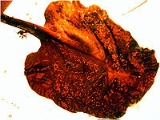
Hymenaea protera
Encyclopedia
Hymenaea protera is an extinct prehistoric leguminous tree, the probable ancestor of present-day Hymenaea
species. Most neotropical amber
s come from its fossil
ized resin
, including the famous Dominican amber
.
H. protera once grew in an extensive range stretching from southern Mexico
down to the Proto-greater Antilles
, across northern South America
, and on to the African continent. Both morphology
and DNA
studies have revealed that H. protera was more closely related to the only species of Hymenaea remaining in East Africa
than to the more numerous American species.
In 1993, chloroplast
DNA
dated at 35-40 million years old was extracted from the leaf of H. protera, preserved in a fossil amber
from the La Toca mines, Dominican Republic
.
Hymenaea
Hymenaea L. is a genus in the flowering plant family Fabaceae . Of fourteen living species in the genus, all but one are native to the tropics of the Americas, with one additional species on the east coast of Africa. Some authors place the African species in a separate monotypic genus, Trachylobium...
species. Most neotropical amber
Amber
Amber is fossilized tree resin , which has been appreciated for its color and natural beauty since Neolithic times. Amber is used as an ingredient in perfumes, as a healing agent in folk medicine, and as jewelry. There are five classes of amber, defined on the basis of their chemical constituents...
s come from its fossil
Fossil
Fossils are the preserved remains or traces of animals , plants, and other organisms from the remote past...
ized resin
Resin
Resin in the most specific use of the term is a hydrocarbon secretion of many plants, particularly coniferous trees. Resins are valued for their chemical properties and associated uses, such as the production of varnishes, adhesives, and food glazing agents; as an important source of raw materials...
, including the famous Dominican amber
Dominican amber
Dominican amber is amber from the Dominican Republic. Resin from the extinct species Hymenaea protera is the source of Dominican amber and probably of most amber found in the tropics....
.
H. protera once grew in an extensive range stretching from southern Mexico
Mexico
The United Mexican States , commonly known as Mexico , is a federal constitutional republic in North America. It is bordered on the north by the United States; on the south and west by the Pacific Ocean; on the southeast by Guatemala, Belize, and the Caribbean Sea; and on the east by the Gulf of...
down to the Proto-greater Antilles
Antilles
The Antilles islands form the greater part of the West Indies in the Caribbean Sea. The Antilles are divided into two major groups: the "Greater Antilles" to the north and west, including the larger islands of Cuba, Jamaica, Hispaniola , and Puerto Rico; and the smaller "Lesser Antilles" on the...
, across northern South America
South America
South America is a continent situated in the Western Hemisphere, mostly in the Southern Hemisphere, with a relatively small portion in the Northern Hemisphere. The continent is also considered a subcontinent of the Americas. It is bordered on the west by the Pacific Ocean and on the north and east...
, and on to the African continent. Both morphology
Morphology (biology)
In biology, morphology is a branch of bioscience dealing with the study of the form and structure of organisms and their specific structural features....
and DNA
DNA
Deoxyribonucleic acid is a nucleic acid that contains the genetic instructions used in the development and functioning of all known living organisms . The DNA segments that carry this genetic information are called genes, but other DNA sequences have structural purposes, or are involved in...
studies have revealed that H. protera was more closely related to the only species of Hymenaea remaining in East Africa
East Africa
East Africa or Eastern Africa is the easterly region of the African continent, variably defined by geography or geopolitics. In the UN scheme of geographic regions, 19 territories constitute Eastern Africa:...
than to the more numerous American species.
In 1993, chloroplast
Chloroplast
Chloroplasts are organelles found in plant cells and other eukaryotic organisms that conduct photosynthesis. Chloroplasts capture light energy to conserve free energy in the form of ATP and reduce NADP to NADPH through a complex set of processes called photosynthesis.Chloroplasts are green...
DNA
DNA
Deoxyribonucleic acid is a nucleic acid that contains the genetic instructions used in the development and functioning of all known living organisms . The DNA segments that carry this genetic information are called genes, but other DNA sequences have structural purposes, or are involved in...
dated at 35-40 million years old was extracted from the leaf of H. protera, preserved in a fossil amber
Amber
Amber is fossilized tree resin , which has been appreciated for its color and natural beauty since Neolithic times. Amber is used as an ingredient in perfumes, as a healing agent in folk medicine, and as jewelry. There are five classes of amber, defined on the basis of their chemical constituents...
from the La Toca mines, Dominican Republic
Dominican Republic
The Dominican Republic is a nation on the island of La Hispaniola, part of the Greater Antilles archipelago in the Caribbean region. The western third of the island is occupied by the nation of Haiti, making Hispaniola one of two Caribbean islands that are shared by two countries...
.

